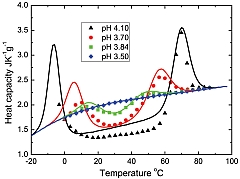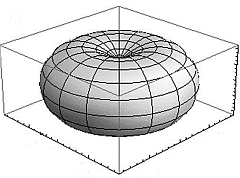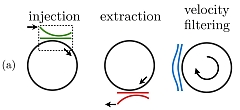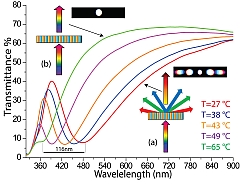Vol. 45 No.4 - Highlights
Transparent conducting device for electromagnetic waves (Vol. 45 No.4)
It is highly desirable to make a metal transparent for electromagnetic waves, owing to many application requests for transparent metals in optoelectronics devices. However, it is well known that a high-conducting metal with a high electron density is generally opaque for electromagnetic waves, since the metal’s permittivity is generally very negative at optical frequencies. Here, a freestanding transparent conducting device based on multilayer metamaterials is theoretically demonstrated at terahertz frequencies. It is realized by depositing periodic metallic patches on top and bottom of the subwavelength metallic mesh. The high transmission of the designed system is attributed to the impedance matching to the vacuum. This design of a transparent conducting device opens a high transmission window within the technologically relevant THz frequency range. This device may find plenty of applications in optoelectronic electrodes, micro-electronic displays, and the miniaturization and integration of THz components, where both high electrical conductivity and high optical transmission are desirable.
Z. Song, Z. Gao, Y. Zhang and B. Zhang, “Terahertz transparency of optically opaque metallic films”, EPL, 106, 27005 (2014)
[Abstract]
Particles near absolute zero do not break the laws of physics (Vol. 45 No.4)
 A free particle strongly coupled to a heat bath. Credit: Adamietz et al.
A free particle strongly coupled to a heat bath. Credit: Adamietz et al.
A change of models demystifies anomalous particle behaviour at very low temperatures, confirming that the third law of thermodynamics cannot be violated
In this work, the authors have demonstrated that a theoretical model of the environment’s influence on a particle does not violate the third law of thermodynamics, despite appearances to the contrary. These findings are relevant for systems at the micro or nanometer scale that are difficult to decouple from the heat or the quantum effects exerted by their environment.
Previous theoretical predictions suggested that, under certain circumstances, the specific heat—the amount of energy is needed to raise the temperature of a particle coupled to a heat bath by a certain amount—can decrease below zero at strictly zero temperature (−273.15 °C). This prediction appears to breach the third law of thermodynamics, indicating that the specific heat must drop to zero value at strictly zero temperature. Yet, these findings show that previous studies need to be modified in order to account for a spatial confinement of the particle.
R. Adamietz, G.-L. Ingold and U. Weiss, “Thermodynamic anomalies in the presence of general linear dissipation: from the free particle to the harmonic oscillator”, Eur. Phys. J. B, 87, 90 (2014)
[Abstract]
Nanoscale heat flow predictions (Vol. 45 No.4)
 Snapshot of the final configuration of a nc-Si sample. Credit: Melis et al.
Snapshot of the final configuration of a nc-Si sample. Credit: Melis et al.
A new study predicts that heat flow in novel nanomaterials could contribute to creating environmentally friendly and cost-effective nanometric-scale energy devices.
Physicists are now designing novel materials with physical properties tailored to meet specific energy consumption needs. Before these so-called materials-by-design can be applied, it is essential to understand their characteristics, such as heat flow. Now, the authors have developed a predictive theoretical model for heat flux in these materials, using atom-scale calculations. These findings could have implications for optimizing the thermal budget of nanoelectronic devices or in the production of energy through thermoelectric effects in novel nanomaterials.
The authors adopted a method called approach equilibrium molecular dynamics (AEMD), which is robust and suitable for representing large systems to deliver trustworthy predictions on thermal transport. Ultimately, the model could be applied to semiconductors used as high-efficiency thermoelectrics, and to graphene nanoribbons used as heat sinks for so-called ultra large scale integration devices, such as computer microprocessors.
C. Melis, R. Dettori, S. Vandermeulen and L. Colombo, “Calculating thermal conductivity in a transient conduction regime: theory and implementation”, Eur. Phys. J. B, 87, 96 (2014)
[Abstract]
Microgravity and aqueous wet foams (Vol. 45 No.4)
 Foam made in the device elaborated by Astrium for the future foam studies in the ISS.
Foam made in the device elaborated by Astrium for the future foam studies in the ISS.
Foams and foaming processes pose interesting questions for both fundamental research and practical applications. Although foams are a familiar thing, both in our everyday lives and in industry, many aspects of foam physics and chemistry still remain unclear.
This work comprehensively reviews the studies of foams under microgravity, including studies conducted in parabolic flights, in sounding rockets and in the International Space Station.
Experiments on foams performed under microgravity can be extended far beyond the conditions of experiments carried out on Earth. In particular, when gravity is minimized, it is possible to observe the behaviour of wet foams obtained during the foaming process. On Earth, foams at this stage evolve too quickly due to gravity drainage and cannot be studied.
D. Langevin and M. Vignes-Adler, “Microgravity studies of aqueous wet foams”, Eur.Phys. J. E, 37, 16 (2014)
[Abstract]
Gap function of hexagonal pnictide superconductor SrPtAs (Vol. 45 No.4)
 Above: Quasiparticle equal energy (ω) surfaces for A1g(a) and Eg(b) gap functions at ω/Δ0=0.5 (Δ0 is the gap amplitude). Below: QPI spectrum (c,d) for corresponding gap functions. The scattering vectors qi are characteristic for the nodal gap structure.
Above: Quasiparticle equal energy (ω) surfaces for A1g(a) and Eg(b) gap functions at ω/Δ0=0.5 (Δ0 is the gap amplitude). Below: QPI spectrum (c,d) for corresponding gap functions. The scattering vectors qi are characteristic for the nodal gap structure.
The pnictide superconductor SrPtAs has a hexagonal layered structure that breaks in-plane inversion symmetry while overall the crystal is still centrosymmetric. This has peculiar consequences for the electronic structure as well as the Cooper pairing. It leads to a strong Rashba spin orbit coupling and splitting of quasi-2D 5d Pt bands that dominate the Fermi surface. Although the superconducting gap functions are even or odd under inversion the in-plane pairing is nevertheless a mixture of singlet and triplet pairs due to the large Rashba coupling. Microscopic theories have obtained possible s+f and p+d wave candidates with unconventional nodal structure. We propose to apply Bogoliubov quasiparticle interference (QPI) technique to SrPtAs which records the spectral density fluctuations at the surface due to impurities. We show that their analysis can give important clues on the nodal structure of the unknown SrPtAs gap function.
A. Akbari and P. Thalmeier, “Gap function of hexagonal pnictide superconductor SrPtAs from quasiparticle interference spectrum”, EPL, 106, 27006 (2014)
[Abstract]
Deeper insights into protein folding (Vol. 45 No.4)
 Structure of staphylococcal nuclease. Credit: Yakubovich et al.
Structure of staphylococcal nuclease. Credit: Yakubovich et al.
Physicists have published a new theory explaining the mechanism of protein folding and unfolding in water.
The authors have produced a new theoretical study of a protein macromolecules changing from a coil structural formation to a globular one. Their statistical mechanics model describes for the first time the thermodynamic properties of real proteins in aqueous environments using a minimal number of free physical parameters.
In this work, the authors confirmed the validity of their theoretical calculation of dependencies of the protein heat capacities on temperature by comparing it with the corresponding experimental measurements for two proteins, namely an enzyme called staphylococcal nuclease and an oxygen and iron carrier protein called metmyoglobin. Sudden changes in temperature could result in the loss of proteins’ three-dimensional structure, and of their function. Thus, these findings could contribute to our understanding of high-energy ion therapy for biological cells.
A. V. Yakubovich and A. V. Solov'yov, “Quantitative thermodynamic model for globular protein folding”, Eur. Phys. J. D, 68, 145 (2014)
[Abstract]
Anisotropic light emission from aligned luminophores (Vol. 45 No.4)
 Calculated mission profiles from homeotropically aligned dichroic luminophores illuminated from directly overhead with an order parameter of S2,opt=0.6.
Calculated mission profiles from homeotropically aligned dichroic luminophores illuminated from directly overhead with an order parameter of S2,opt=0.6.
Organic dichroic dyes are neither isotropic in absorption nor in emission. By aligning the fluorophores using liquid crystals, for example, one may gain a degree of control over both the absorption and emission directions of the light. Controlling of light emission directions could have significant impact on the performance of devices such as organic LEDs or luminescent solar concentrators, the latter of which have potential for use as solar energy generators in the built environment. Commercial ray tracing software does not take this dichroism into account, and thus cannot model these devices correctly. In this paper, we develop a simple formalism to describe the resulting emission from a collection of dichroic dyes with arbitrary alignment, including the extremes of planar and homeotropic, and for various degrees of disorder about this alignment. We demonstrate close agreement of the calculations with experimental studies. We close the discussion by accentuating the importance of incorporating these calculations into functioning simulation systems to allow in silico optimization of the devices which will accelerate their entrance into the commercial sphere.
P. P. C. Verbunt, T. M. de Jong, D. K. G. de Boer, D. J. Broer and M. G. Debije, “Anisotropic light emission from aligned luminophores”, Eur. Phys. J. Appl. Phys., 67, 10201 (2014)
[Abstract]
A vortex of eigenvalues (Vol. 45 No.4)
 Rotating vortex patches behave like clumps of eigenvalues for random matrices.
Rotating vortex patches behave like clumps of eigenvalues for random matrices.
As the size of a random normal matrix grows, so does the number of its eigenvalues. As this number tends to infinity (with the mutual “repulsion” of eigenvalues reducing simultaneously) the eigenvalues “clump together” into a finite collection of dense, uniform, regions. Here we demonstrate the surprising result that exactly the same phenomenon pertains to rotating equilibrium arrangements of vorticity - so-called “vortex patches” or “V-states” – whose dynamics are governed by the famous Euler equations for ideal fluids. The underlying mathematical structure in these quite distinct areas of physics turns out to be identical.
The connection is made via an inverse moment problem in which the geometry (of either the limiting eigenvalue distribution, or the vortex patches) is dictated by an imposed background potential, but in an indirect way that must be decoded. This analogy is significant not only because it links two erstwhile unconnected areas of study, but also because it affords valuable mathematical “technology transfer”, especially with respect to decoding the shape of what we might now call the limiting “vortex of eigenvalues” in random matrix theory.
D. G. Crowdy, “Vortex patch equilibria of the Euler equation and random normal matrices”, J. Phys. A: Math. Theor., 47, 212002 (2014)
[Abstract]
Ultra-cold atom transport made simple (Vol. 45 No.4)
 Schematic representation of the physical system consisting of a ring trap and two dipole waveguides for injecting neutral atoms into, extracting them from, and velocity filtering them in the ring waveguide. Credit: Loiko et al.
Schematic representation of the physical system consisting of a ring trap and two dipole waveguides for injecting neutral atoms into, extracting them from, and velocity filtering them in the ring waveguide. Credit: Loiko et al.
New study provides proof of the validity of a filtering device for ultra-cold neutral atoms based on tunnelling.
A new study gives a proof of principle, confirmed by numerical simulations, of the applicability to ultra-cold atoms of a very efficient and robust transport technique called spatial adiabatic passage (SAP). The authors have, for the first time, applied SAP to inject, extract, and filter the velocity of neutral atoms from and into a ring trap.
They focused on controlling the transfer of a single atom between the outermost waveguides of a system composed of two dipole waveguides and a ring trap, using the SAP technique. They calculated the explicit conditions for SAP tunnelling, which depend on two factors: the atomic velocity along the input waveguide and the initial atom population distribution among what physicists refer to as the transverse vibrational states.
To check the performance of the proposed approach, they relied on a numerical integration of the corresponding equation with parameter values for rubidium atoms and an optical dipole ring trap.
Y. Loiko, V. Ahufinger, R. Menchon-Enrich, G. Birkl and J. Mompart, “Coherent injecting, extracting, and velocity filtering of neutral atoms in a ring trap via spatial adiabatic passage”, Eur. Phys. J. D, 68, 147 (2014)
[Abstract]
Tuneable broadband optical filter based on soft-composite materials (Vol. 45 No.4)
 Spectral response versus temperature and schematic rapresentation of the filter mechanism in states ON (a) and OFF (b).
Spectral response versus temperature and schematic rapresentation of the filter mechanism in states ON (a) and OFF (b).
We realized a free-space, polarization sensitive, broadband, widely tunable, optical filter by exploiting a micro-composite holographic grating made of polymer slices alternated with films of aligned Nematic Liquid Crystals (NLC). Impinging probe light (p-polarized) experiences a refractive index modulation (Δng); thus, it is transmitted/diffracted and, consequently, angularly separated into its fundamental colours, according to the sketch of Figure (a). This diffraction effect induces a band-gap behaviour (filter in the ON state) in the transmission properties featured by the structure (Figure (a), red curve) and in the corresponding far field diffraction pattern. Both electric fields and temperature variations can be exploited to tune the position of the diffractive band-gap; in particular, by increasing the sample temperature, a nematic to isotropic transition of the NLC component gradually reduces Δng, with a resulting blue shift and a gradual suppression of the diffraction band (Figure (a), green curve). Under these conditions, light is almost completely transmitted (filter in the OFF state) as shown in the far field diffraction pattern and in the corresponding sketch reported in Figure (b).
L. De Sio, V. Caligiuri and C. Umeton, “Tuneable broadband optical filter based on soft-composite materials”, J. Opt., 16, 065703 (2014)
[Abstract]






